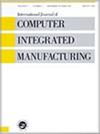Quality–efficiency coupling prediction and monitoring-based process optimization of thin plate parts with multi-machining feature
IF 3.7
3区 工程技术
Q2 COMPUTER SCIENCE, INTERDISCIPLINARY APPLICATIONS
International Journal of Computer Integrated Manufacturing
Pub Date : 2023-10-16
DOI:10.1080/0951192x.2023.2264831
引用次数: 0
Abstract
ABSTRACTQuality and efficiency prediction, as well as coupling optimization, is very important for improving product production. However, most of the researches are studying the quality and efficiency separately, which makes it difficult to improveproduction. Therefore, this paper proposes a quality–efficiency coupling prediction and monitoring-based process optimization method to effectively improve the quality and efficiency of thin plate parts with multi-machining features at the same time. And the best process parameters are recommended to better improve machining stability. Firstly, based on the generalized multi-layer residual network and deep neural network (MLResNet-DNN), the prediction models of quality and efficiency are constructed, respectively. Secondly, the quality–efficiency coupling index is constructed based on coupled permutation entropy (CPE) accordingly. Finally, the process optimization model based on the hybrid artificial bee colony–particle swarm optimization (HABC-PSO) algorithm is established to recommend the best process parameters according to the monitoring results of quality–efficiency CPE. The RMSE average value of the proposed quality and machining time prediction model has an average improvement of at least 10.8% and 25.9%, respectively, than other prediction model. The process parameters recommended by the proposed HABC-PSO method have improved the machining stability of quality and efficiency by at least 25.6%, and machining time is reduced by at least 25.7% compared with other optimization algorithms.KEYWORDS: Quality–efficiency couplingMLResNet-DNNcoupling permutation entropyT-square statisticscoupling monitorprocess optimization Disclosure statementNo potential conflict of interest was reported by the author(s).Additional informationFundingThis work is financially supported in part by the project supported by the National Natural Science Foundation of China (52275507) and in part by the Major Science and Technology Special Project in Shannxi Province of China (2019zdzx01-01-02).基于多加工特征薄板零件质量-效率耦合预测与监测的工艺优化
摘要质量和效率预测及耦合优化对提高产品生产效率具有重要意义。然而,大多数研究都是将质量和效率分开研究,这给提高产量带来了困难。为此,本文提出了一种基于质量-效率耦合预测与监测的工艺优化方法,以有效提高同时具有多种加工特征的薄板零件的质量和效率。并推荐了最佳工艺参数,以更好地提高加工稳定性。首先,基于广义多层残差网络和深度神经网络(MLResNet-DNN),分别构建了质量和效率的预测模型;其次,基于耦合排列熵(CPE)构造了相应的质效耦合指标;最后,建立了基于混合人工蜂群-粒子群优化(HABC-PSO)算法的工艺优化模型,根据质量-效率CPE监测结果推荐最佳工艺参数。所提出的质量和加工时间预测模型的RMSE平均值比其他预测模型分别提高了10.8%和25.9%。与其他优化算法相比,HABC-PSO方法推荐的工艺参数使加工质量和效率的稳定性提高了至少25.6%,加工时间减少了至少25.7%。关键词:质量-效率耦合mlresnet - dnn耦合排列熵方统计耦合监测过程优化披露声明作者未报告潜在的利益冲突。项目资助:国家自然科学基金项目(52275507)和陕西省科技重大专项项目(2019zdzx01-01-02)资助。
本文章由计算机程序翻译,如有差异,请以英文原文为准。
求助全文
约1分钟内获得全文
求助全文
来源期刊
CiteScore
9.00
自引率
9.80%
发文量
73
审稿时长
10 months
期刊介绍:
International Journal of Computer Integrated Manufacturing (IJCIM) reports new research in theory and applications of computer integrated manufacturing. The scope spans mechanical and manufacturing engineering, software and computer engineering as well as automation and control engineering with a particular focus on today’s data driven manufacturing. Terms such as industry 4.0, intelligent manufacturing, digital manufacturing and cyber-physical manufacturing systems are now used to identify the area of knowledge that IJCIM has supported and shaped in its history of more than 30 years.
IJCIM continues to grow and has become a key forum for academics and industrial researchers to exchange information and ideas. In response to this interest, IJCIM is now published monthly, enabling the editors to target topical special issues; topics as diverse as digital twins, transdisciplinary engineering, cloud manufacturing, deep learning for manufacturing, service-oriented architectures, dematerialized manufacturing systems, wireless manufacturing and digital enterprise technologies to name a few.

 求助内容:
求助内容: 应助结果提醒方式:
应助结果提醒方式:


